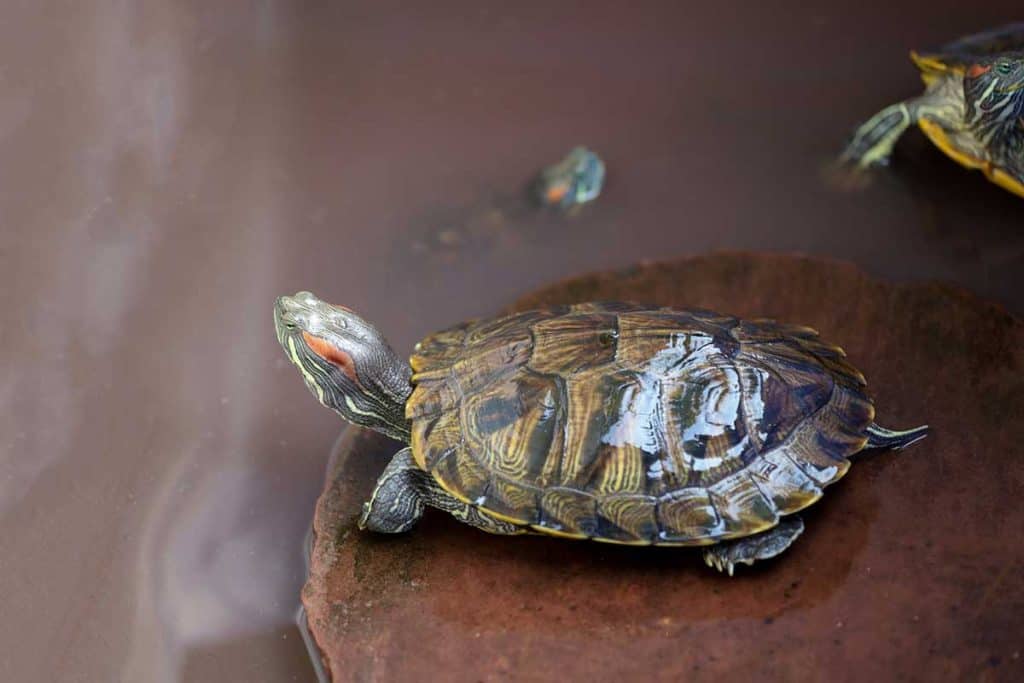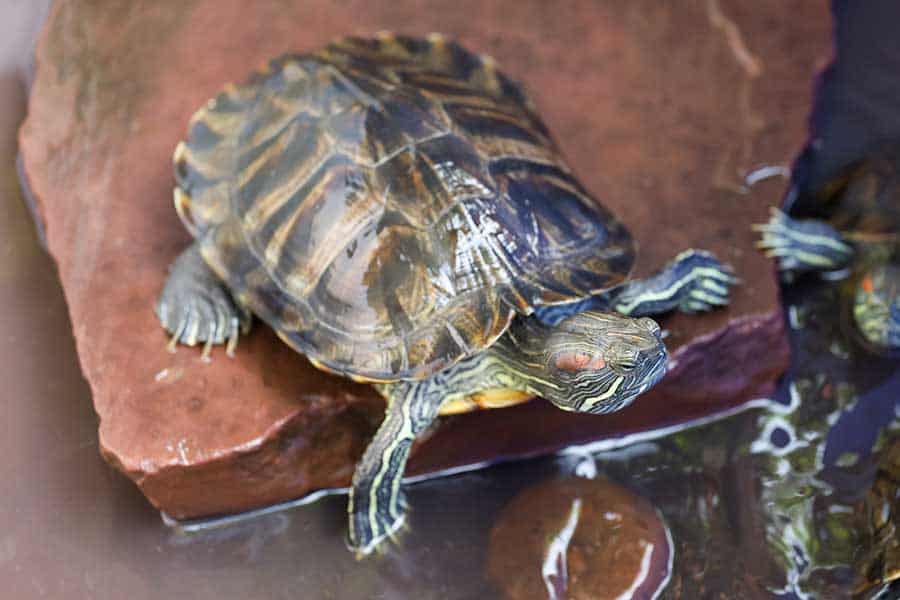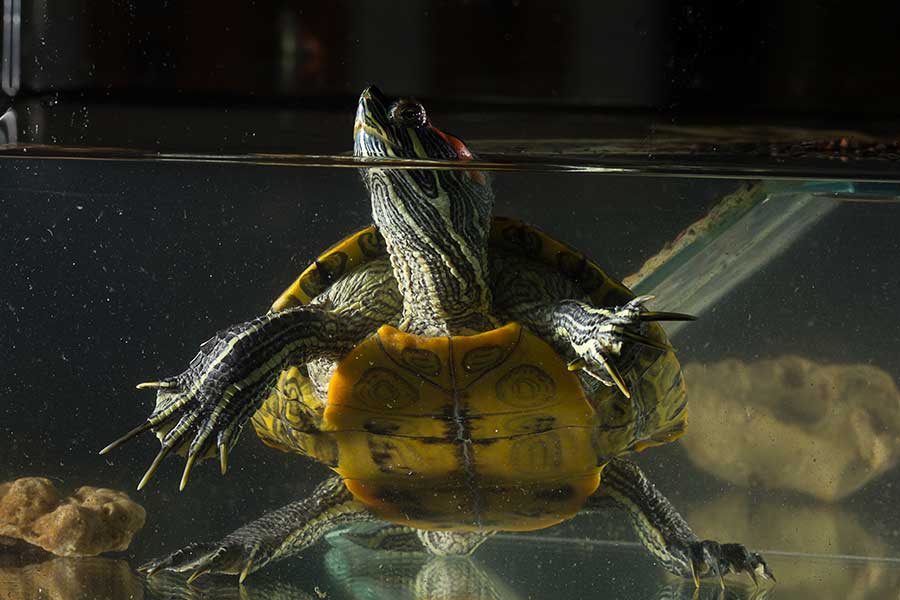Red-eared slider turtles are one of the best and easiest turtles to own as pets. If you are making the exciting jump to owning a semi-aquatic turtle species, you may be wondering how to set up your red-eared slider’s tank.
Red-eared slider turtles are semi-aquatic, which means they spend a lot of their time in the water. The best environments for them must be carefully controlled, but thankfully, indoor setups for red-eared slider turtles are not too complicated.
Having an indoor enclosure setup also means you can watch your red-eared slider going about their daily life. These are very active turtles who love to dive, swim about, and dig in their surroundings. Their energetic, curious behavior will provide you with endless hours of enjoyment.
Setting up your turtle tank can seem daunting at first because there are so many parts to consider, but do not fear! This article will guide you through what you need to do.
Red-Eared Slider Turtle: A Natural History
Red-eared slider turtles come from the southeastern part of North America in regions that are fairly warm and have lots of small ponds that do not freeze in the winter.
They are fairly small as far as turtles go at only 7 to 12 inches in length on average. However, they make up for their small stature in the length of their lifespan. If properly cared for, red-eared slider turtles can live for 20 to 30 years!
These turtles have the typical flattened shell that is quite dark on top (carapace) and lighter on the bottom (plastron) to help them blend in with their surroundings. They have prominent red streaks along their necks stretching up to their faces, which gives them their name.
All the toes on their webbed feet are tipped with little claws, which help them move around on land when they need to leave the water.
How to Set Up Your Red-Eared Slider Turtle’s Tank
It is important to set up your tank and let it run for at least a week or two before your turtle comes home. There are a couple of important reasons for this:
- The water will need to cycle for a bit in order to achieve the correct parameters.
- Your filter will need to run in order to build up filter media.
- You will need to make frequent changes to the lighting and heating elements in order to get all of the settings right consistently.
- If you make all of these changes with your new turtle inside of the tank, you will stress it out and possibly make it sick.
To set up your red-eared slider’s tank, you will need all of the following materials:
- Turtle tank (20+ gallons for hatchlings; 80 to 100+ gallons for adults)
- Substrate
- Decorations
- Heat source for the basking spot and a
thermometer - Heat source for the water and a
thermometer - Lighting
- Water that meets the correct parameters and a test kit
- Filter
The specifications for all of these items can be found detailed below.
Tank Size
A hatchling red-eared slider turtle should be housed in a tank that is no smaller than 20 gallons. However, keep in mind this tank will eventually need to be changed out for a much, much, much larger one as your turtle grows older.
A good rule of thumb for tank size for red-eared slider turtles is, for every inch of their shell, add 10 gallons to the enclosure. This means in all likelihood you will need to purchase a 100-gallon enclosure for your average-sized, fully-grown red-eared slider.
Some red-ears have even grown to be as large as 16 inches in length, which means they would ideally need an enclosure that is 160 gallons in size! This is much larger than your average reptile or fish tank, so make sure you can fit a tank this size in your home if needed.
If you cannot fit a tank this size in your home, perhaps consider another species of turtle, tortoise, snake, gecko, lizard, or amphibian that can thrive in a smaller, more easily managed enclosure.
Tank Type
The type of tank you choose is important. Your red-eared slider needs a deep and long tank to swim around. They are very active animals, and if they do not have adequate space to swim, they will become very bored, which will impact their quality of life and shorten their lifespan.
The tank will also need to be completely watertight, as it will need to contain a lot of water. You should also be able to put it on a stable stand to hold the weight of the large tank as well as the water. Large, sturdy glass tanks designed for aquatic animals are generally the best choice for red-eared sliders.
Substrate
Once you have the tank set up on its stand, you can add substrate.
The substrate choice is important. If the substrate pieces are too small, your turtle can ingest them, and this will lead to impaction. A mixture of large and medium stones or aquarium sand is ideal.
If you wish to have a natural-looking tank with live plants, then you can add aquarium soil! This will provide good anchorage for your live plants as well as a natural feel for your turtle.
Decorations
Once you have placed the substrate into the enclosure, you can start decorating! Choose your decorations wisely and try not to overcrowd the enclosure.
One very important decoration is the basking platform. This should ideally be a sturdy shelf or large rock that is completely out of the water that your turtle can easily climb onto to bask and dry out at their leisure. It is important that your turtle can access the basking platform easily and at all times.
The rest of the enclosure’s decorations should be kept to a minimum so your turtle has plenty of space to swim around. Logs, large stones, shells, and fake plants are all good decoration items.
You can include live plants in the enclosure; however, this will mean you’ll have a lot more to take care of in the tank, and your turtle may end up munching on the plants from time to time.
Land Heating/Basking
Once you have installed the basking platform, you will need to adjust the light and the distance of the light to the platform to achieve the right temperature.
The basking platform needs to be heated appropriately with a basking bulb. The platform should be at 90°F to 95°F, and the rest of the air in the enclosure should be between 80°F and 85°F.
Water Heating
The tank also needs a water heater. When buying the water heater, make sure it can adequately heat water in a 100-gallon tank (or whichever sized tank you have) so there are no cold spots in the water. The water temperature should not fluctuate, and it should sit at 74°F to 78°F at all times.
When you are changing the water and cleaning the tank, you should turn off the heating element so it does not overheat if the water level drops and exposes the heater.
Additionally, make sure you do not turn the water heater back on until the tank is filled.
Lighting
Red-eared slider turtles need full-spectrum lighting. This means they need an additional UVB light in their enclosure.
Their lights should be on a timer, or you will need to turn them on and off manually each day. They need 12 hours of light and 12 hours of dark to simulate the natural rising and setting of the sun. During their dark hours, their basking light will also need to be turned off.
Filter and Water Parameters
Your red-eared slider’s tank will need a filter that suits the size of the tank. This is important to keep in mind when buying a filter. If the filter is not powerful enough, then the tank will not be clean enough for your turtle.
A powerful, quality filter is essential because it maintains the water’s cleanliness for your turtle. Red-eared sliders are very messy, and the filter will help keep the water clear and toxin-free, which will greatly improve your turtle’s quality of life and lengthen their lifespan overall.
| Water Parameters | Level |
| pH balance | 6 to 8 |
| Ammonia | 0 |
| Nitrites | 0 |
| Nitrates | 0 |
It is essential that you keep an eye on the water parameters of the water in the tank and make adjustments as necessary. Test the water every third day with a water testing kit.
An Important Note on Shell Rot
Red-eared slider turtles in particular have very porous shells. They need to periodically bask on dry land to warm up and dry out their shells.
If they cannot dry out their shells properly, it means they constantly stay wet and soft, which provides the perfect breeding ground for bacteria and fungi to develop. If these bacteria and fungi have a chance to enter the shell, they will start eating away at it and cause shell rot.
Another way red-eared slider turtles get shell rot is by having unclean water. This is particularly a problem when there is cross-contamination between pets and humans due to unsanitized hands and equipment being used between different enclosures and tanks.
Fortunately, shell rot is not very serious if you catch it early and treat it at home. However, if left untreated, the shell rot will extend deep into the shell and into the red-eared slider turtle’s bloodstream, causing them serious illness and eventually death.
For more information, take a look at our guide on how to tell the differences between healthy shedding and shell rot as well as how you can treat and avoid shell rot!
FAQs About Red-Eared Slider Turtle Tanks
Can I put red-eared slider turtles in my pond outside?
Yes, in some cases, you can keep your red-eared slider turtles in an outdoor pond! However, you will need to keep a number of things in mind.
- Your turtles need an ambient temperature suited to their needs, so living in an especially cold or hot climate is not suitable.
- Your turtle needs a basking spot on dry land as well as access to the pond.
- Your turtle needs to be protected from predators such as cats, dogs, birds, coyotes, alligators, and people who would prey on or potentially even steal your turtle.
Can I put multiple red-eared sliders in the same tank?
The good news about red-eared slider turtles is they are relatively small and get along well with other members of their species! You can keep multiple sliders in the same indoor tank or outdoor pond. However, the turtles need to be around the same size to prevent them from competing with or bullying one another.
In addition to this, you will need to extend the size of their enclosure by 20 gallons for every additional turtle you add to the tank and provide them with extraterrestrial space to dry out on and bask appropriately. This is especially important to ensure younger or more submissive turtles don’t miss out on basking time.
Can I put fish in my red-eared slider turtle tank?
You can keep certain kinds of small fish with your red-eared slider turtle. However, you need to acknowledge that there are risks associated with this. The fish and the turtles can take bites out of each other if they are feeling threatened, aggressive, or hungry.
You can add guppies, goldfish, minnows, zebrafish, and koi fish to the tank as long as their needs are met and the enclosure size is increased slightly to accommodate them.
How do I clean my red-eared slider turtle’s tank?
You will need to spot clean your red-eared slider turtle’s enclosure every day. Make sure you look for any messes they have made and remove all uneaten food.
Every second week, you should cycle a third of their water and replace it with clean water meeting their tank parameters. During this cycle, you will need to suction their substrate and remove any artificial decorations and give them a scrub.
This is also a good time to check your filter for filter material and scrape away any build-up on the outside of the filter.
You can even give your turtle a little scrub if you see any build-up on their shell! Always use clean water, a clean, soft-bristled toothbrush, and gentle dish soap on their shells. Never let any soap get in their eyes or mouth.
During the time it takes you to properly clean the tank, you can dry dock your turtle to ensure they are getting their shells completely dried out. While you dry dock them, look for any signs of illness and shell rot.
Slide Into the Turtle Tank
A red-eared slider tank is an investment. However, once you have purchased all of the fundamental items, it is all about maintenance and keeping an eye on any changes.
Red-eared slider turtles are awesome pets because they are so hardy, and they can sustain some small beginner mistakes. It is important to do as much research as you can before you decide to buy one.
Setting up your pet turtle’s tank properly certainly takes some time and dedication from you. However, if it is done right, it will make a beautiful addition to any room, and it will help your turtle live a very long and happy life.




